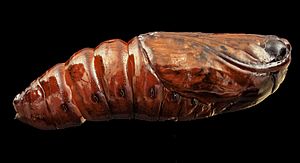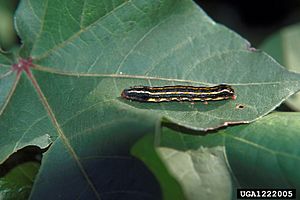Southern armyworm facts for kids
Quick facts for kids Southern armyworm |
|
|---|---|
 |
|
| Imago | |
 |
|
| Pupa | |
| Scientific classification | |
| Synonyms | |
|
The Spodoptera eridania, also known as the southern armyworm, is a type of moth. It is often seen as a pest because its young, called larvae or caterpillars, eat a lot of plants. They can strip leaves down to their veins, making them look like skeletons. These caterpillars especially love to eat tomato plants in places like Florida.
Scientists are working on ways to control these moths. One promising method uses pesticides made from the neem tree. These natural pesticides can make the caterpillars smaller and slow down their growth. Adult southern armyworm moths have a wingspan of about 33–38 mm. They can be found flying all year round. The caterpillars eat many different weeds, but they really like Amaranthus species and Phytolacca americana.
Contents
Where They Live
The southern armyworm, S. eridania, is found across a large area. You can find them in North America, especially in the southern US states like Kansas and New Mexico. They also live throughout the Caribbean and Central America, and down into South America, all the way to Argentina. They have also been found in countries like Nigeria and Cameroon in Africa.
What They Eat
Favorite Plants
Southern armyworms eat a wide variety of plants. These include many important vegetables, fruits, and crops. Some vegetables they eat are beet, cabbage, carrot, collard, cowpea, eggplant, okra, pepper, potato, sweet potato, tomato, and watermelon. They also damage fruits like avocado and citrus, and crops such as peanut, sunflower, velvet bean, and tobacco. They rarely eat grasses. One of their favorite plants is the lima bean. This might be because lima beans contain a natural chemical called linamarin.
Plant Defenses
Some plants have natural defenses called glucosinolates. These chemicals can stop insects like the southern armyworm from eating them. If a plant has more of these chemicals, the armyworm will eat less of it. This suggests that these plant defenses might have developed to protect against many different types of plant-eating insects.
How They Harm Plants
When they are young, southern armyworm caterpillars eat together in groups. They often eat leaves until only the veins are left. As they get older, they start to eat alone. They can also bore into fruits, causing a lot of damage to tomatoes in Florida. If not controlled, they can cause big losses for farmers. If they don't have enough food, they might even eat the tips of branches, bore into stems, or attack plant roots near the soil surface.
Ways to Control Them
Neem-Based Products
Many studies have looked into using products made from the neem tree to control insects. Farmers are becoming more interested in using natural plant-based insecticides. Neem has been shown to stop insects from eating. The main active part of neem is a chemical called azadirachtin. This chemical can affect many different types of plant-eating insects.
Neem products can mess with how armyworm caterpillars eat and digest food. This makes them grow slower and take longer to develop. Neem-based pesticides are good because they can poison insects, stop their growth, repel them, and even prevent them from changing into adult moths. Pure neem oil seems to be the best at stopping them from eating, especially for younger caterpillars.
GMO Soybean Plants
Scientists have also studied genetically modified soybean plants. These plants are made with special genes from a bacteria called Bacillus thuringiensis (Bt). These Bt plants are grown more and more around the world. Research shows that Bt soybeans don't stop the caterpillars from eating, but they do make the caterpillars develop faster.
Bt Corn
Caterpillars that ate fresh corn ears with Bt proteins (Cry1F and Cry1F + Cry1A.105 + Cry2Ab2) died very quickly, usually within two days. Bt is a natural protein that is toxic to insects but safer than many man-made pesticides. It is also specific to certain insects. While Bt corn is very effective, southern armyworm caterpillars did not develop well when fed on maize leaves.
Soybean Types
In some parts of Brazil, the southern armyworm causes a lot of damage to soybean crops. Farmers have found that certain types of soybeans, like Monsoy 8757, can affect the armyworm's growth. When caterpillars eat this type of soybean, their larval and pupal stages last longer, and their pupae are smaller. This can be good for farmers because it means fewer generations of pests in the field and fewer overall armyworms.
Life Cycle
The southern armyworm usually has about four generations each year in Florida. Adult moths can be found all year, even during freezing weather. However, the caterpillars are mostly seen in northern Florida during the summer. One full life cycle, from egg to adult, takes about 30 to 40 days.
Egg
The eggs are shaped like a flattened sphere, about 0.45 mm wide and 0.35 mm tall. They start out green and turn tan as they get older. The female moth lays her eggs in clusters and covers them with scales from her body. The egg stage lasts for about four to six days.
Larvae
The armyworm caterpillar goes through six growth stages, called instars, reaching about 35 mm long. They are usually green or blackish-green with light brown or reddish-brown markings. Each side has a wide yellowish stripe with a dark spot on the first body segment. They often have a row of dark triangles along their back. Caterpillars are usually found on the lower parts of leaves and are more active at night. The caterpillar stage lasts about 14 to 20 days.
Pupae
When ready to change, the caterpillars burrow into the soil, about 5 to 10 cm deep, to become pupae. The pupae are mahogany brown and about 16–18 mm long. This pupal stage lasts about 11–13 days. Female pupae are often larger than male pupae. Larger pupae, both male and female, tend to result in adults that live for shorter periods. However, larger females often lay more eggs.
Adults
The adult moth has a wingspan of about 33 to 38 mm. Their front wings are gray and brown and can look very different from one moth to another. Some have a bean-shaped spot in the middle, while others don't. Their back wings are shiny white.
Natural Enemies
Several insects are parasitoids of southern armyworm caterpillars. This means they lay their eggs on or inside the caterpillars, and their young then eat the caterpillar.
Wasps
- Campoletis flavicincta
- Chelonus insularis
- Cotesia marginiventris
- Euplectrus platyhypenae
- Meteorus autographae
- Meteorus laphygmae
- Ophion flavidus
Flies
- Choeteprosopa hedemanni
- Eucelatoria rubentis
- Euphorocera claripennis
- Gonia crassicornis
- Lespensia sp.
- Winthemia quadripustulata
- Winthemia rufopicta
How Humans Deal With Them
Management
The best way to control southern armyworms is to use sprays on the leaves when the caterpillars are small. Different insecticides work differently. It can be hard to control them with natural plant-based insecticides. Some older methods involved using bait with insecticide, which works best for larger caterpillars that have left the plants and are on the ground.
Related pages
- Persectania aversa, a moth found in New Zealand, also called the southern armyworm.



